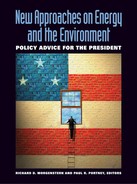0%
39Chapters
0-1Hours read
0kTotal Words
Book Description
Written by economists and policy analysts at Resources for the Future, a Washington, DC, think tank with a tradition for independent, objective research, this collection of twenty-five 'memos to the President' offers constructive policy options for the elected administration on critical challenges related to energy, the environment, and natural resources. Each contributor to New Approaches on Energy and the Environment was asked to address the question: 'Based on your research and knowledge, what policy recommendation would you like to make to the next U.S. president?' Writing in advance of the 2004 election so as to keep their essays free of partisan interpretations, the authors were asked not to confine their suggestions to what the prevailing wisdom says is politically possible. They also took pains to make their ideas accessible to a busy president as well as a wide range of readers interested in a concise and authoritative overview of the nation's energy and environmental policy choices. The results are provocative, sometimes controversial, but highly readable essays on topics including climate change, oil dependency, electricity regulation, brownfields revitalization, forest service administration, air and water quality, and environmental health issues such as food safety and the growing threat of antibiotic resistance. When the President takes office in January, 2005, he will confront competing perspectives about the priorities and approaches that should apply to energy and environmental policy: Americans want cleaner air and water and healthy and attractive surroundings, but they also want inexpensive fuel, comfortable cars and houses, and continued economic growth. New Approaches on Energy and the Environment provides thought-provoking, commonsense contributions to debates about important energy and environmental issues confronting the U.S. today.Table of Contents
- Cover
- Halftitle
- Title
- Copyright
- Contents
- Foreword
- About the Contributors
- Introduction
- PART I. Energy and Climate
- 1. Taking the Lead on Climate Change
- 2. Stimulating Technology to Slow Climate Change
- 3. A Carbon Tax to Reduce the Deficit
- 4. Slaking Our Thirst for Oil
- 5. Stimulating Renewable Energy: A “Green Power” Initiative
- 6. Rewarding Automakers for Fuel Economy Improvements
- 7. Making Electricity Markets Competitive: How Fast and by Whom?
- PART II. Environment, Health, and Safety
- 8. Cleaning Up Power Plant Emissions
- 9. Pay-As-You-Drive for Car Insurance
- 10. State Innovation for Environmental Improvements: Experimental Federalism
- 11. Pay as You Slow: Road Pricing to Reduce Traffic Congestion
- 12. Focus on Particulates More Than Smog
- 13. A New Approach to Air Quality Management
- 14. Redirecting Superfund Dollars
- 15. A Broader View of Brownfield Revitalization
- 16. Modernizing the Food Safety System
- 17. Performance Standards for Food Safety
- PART III. Natural Resources
- PART IV. Information Decision Frameworks
- Index
